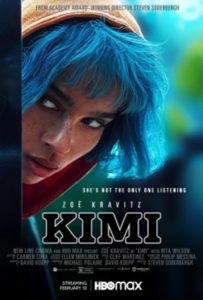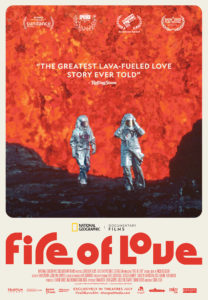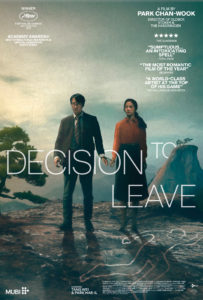The editors of Day for Night have gathered to contribute five reflections to celebrate the publication’s favorite films from 2022. Carefully curated by our writers, these brief vignettes are a tribute to a diverse collection of films and stories.
Foremost to our readers: we hope our words may inspire your own fond recollections from this past year in cinema.
Kimi (Steven Soderbergh)
Following the prediction of COVID-19 with Contagion (2011), 2022 sees Steven Soderbergh’s release of the perfect made-for-streaming film. Kimi’s HBO Max exclusive release competes with Netflix’s The Woman in the Window (Wright, 2021) and Amazon Prime’s The Voyeurs (Mohan, 2021) for the best made-for-streaming pandemic thriller.
 Clocking in at right under ninety minutes, Kimi follows agoraphobic tech worker Angela Childs played by blue-haired Zoë Kravitz. The character’s inward physicality perfectly encapsulates the CDC’s pandemic guidelines: mask up, stay indoors, remain six feet apart, and exercise hand hygiene whenever possible. When Angela hears recorded evidence of a violent crime on a Kimi, a smart home device similar to an Amazon Alexa, she is forced to leave her apartment in an attempt to report the crime.
Clocking in at right under ninety minutes, Kimi follows agoraphobic tech worker Angela Childs played by blue-haired Zoë Kravitz. The character’s inward physicality perfectly encapsulates the CDC’s pandemic guidelines: mask up, stay indoors, remain six feet apart, and exercise hand hygiene whenever possible. When Angela hears recorded evidence of a violent crime on a Kimi, a smart home device similar to an Amazon Alexa, she is forced to leave her apartment in an attempt to report the crime.
Where Soderbergh diverges from his contemporaries is his meticulous devotion to visual storytelling, the Hitchcockian tradition of “to show and not tell”– a master-crafted way of building suspense with visual beats instead of relying on character dialogue or narration. Soderbergh’s direction and cinematography elevate the film just enough for Kimi to feel larger than your average made-for-television movie or streaming mini-series but smaller than an IMAX experience. The incorporation of smooth, clean interior shots, juxtaposed with exterior hand-held footage and the unnatural jerky movements associated with high shutter speeds, exemplifies the contrast of the sleek technological world against the paranoia of a surveillance state. All human activities– movements, biometrics, conversations–are recorded and stored, then utilized by Big Tech companies to increase capital.
Kimi plays as a fun psychological thriller that recalls the eighties and early nineties Brian De Palma, evokes the visual storytelling of Alfred Hitchcock, but is placed in a post-pandemic society where streaming services become the site for the exploration of technology, capital, surveillance, and isolation. Soderbergh’s Kimi surfaces the imposed structures such as pandemic guidelines, terms and conditions, and monthly subscriptions that imprint themselves and regulate the individual bodies that conform to them, all within a speedy eighty-nine minutes.
Chloe Kwiatkowski
Everything Everywhere All at Once (Daniel Kwan and Daniel Scheinert)

Early 2022, An asian woman tried to finish her taxes and millions of people watched her go. The asian woman doing her taxes bit was the official tagline for the movie as it was rolling out to theatres. It is, if you ignore all the multiverse superscience, the perfect description of the movie. An asian woman trying. Trying to get through bureaucracy in a country not built for her, trying to understand her daughter as the two drift further and further apart, trying to prove herself to her father, trying to find what she has lost with her husband. She spends the whole wacky adventure learning how to be a better person and see other people’s points of view by literally seeing through new eyes. She learns about her daughter’s queerness through her own experience in another life. She learns how to appreciate her husband through a life where she doesn’t have him. She learns. It is her defining trait. She learns and grows and that is the point. Well that, and also that there is no point. That’s pretty important too. It’s definitely one of the major messages. After all that learning and growing is over, they are all still faced with the inevitable truth that literally nothing means anything. It is all some random gamble what happens at any given moment, and in a revolutionary turn, that’s OK. it’s actually better like that. Nothing matters so nothing is stopping anyone from living their lives but themselves. This movie is good, not because of the impressive effects, or the epic visuals, but because the characters and their relationships are so deep, real, and relatable. She tried, and after enough work, after enough learning, she succeeded.
Robin Turner
Fire of Love (Sara Dosa)

A documentary about passionate partnership and living boldly, Fire of Love (Dosa, 2022) follows volcanologists Katia and Maurice Krafft as they document and showcase their scientific processes. The cinematography is mostly comprised of crisp, colorful 16mm archival footage, and part of the joy of watching Fire of Love is being visually convinced of the majesty of such dangerous aspects of nature. The film is very direct from the start (and in its trailer) that the Kraffts will die in the Mount Unzen explosion of 1991. Without expecting a “happily ever after”, the audience is free to focus on the momentary joys in life, captured by a couple who were experts in mindfulness. The footage is multifunctional: it is simultaneously scientific evidence, defense of a field that needs more funding, and family home video. Incredibly, Dosa does not rely on the regular bag of documentarian tricks, like reenactments or B-roll, to flesh out the film. All of the footage is original, digitized from a rarely utilized archive collection in France. Fire of Love works in the same vein as other recent footage-driven documentaries like Crip Camp (2020), All the Streets are Silent (2021), and Apollo 11 (2019), though Dosa’s film no longer has access to its subjects for further questioning.
There is no way to ask the Kraffts follow-up questions about their work in the 1980s. Luckily, the Kraffts recorded everything. Though not as famous as Jacques Cousteau (perhaps because of their untimely death in the middle of their careers), Katia and Maurice Krafft are just as charming and evocative representatives for the wonders and importance of scientific research. The documentary’s narration (voiced by Miranda July) is quirky and matches the odd personalities of these scientists, who at various points in the film test a blow-up boat on an acid lake and marvel over the textures of cooled magma and pyroclastics. Fire of Love is a delightful memorial to two scientists who found a way to answer the age-old dilemma: how to follow passion in life and in love, without sacrificing one to the other.
Yelizaveta Moss
Decision to Leave (Park Chan-wook)
The brilliance of Park Chan-wook’s latest film, Decision to Leave (2022), perhaps can be best conveyed with an example of the film’s crafty use of visual motifs. Towards the climax of the film, Detective Hae Joon (Park Hae-il), during an interrogation brings out a surveillance photograph of his primary murder suspect (and love interest), Song Seo Rae (Tang Wei). A stylish digital zoom into the bouquet of roses held by Seo Rae in the photograph doubles as a sly transition, transporting the viewer to the scene of a potential crime as we follow Tang Wei’s mysterious femme fatale.
 The moment is, notably, a recreation of an iconic scene from Alfred Hitchcock’s Vertigo (1958); whereby, the camera, adopting the point-of-view of Jimmy Stewart’s Scotty, pushes in on a portrait of Carlotta Valdes and her own tightly held bouquet of flowers. Where in Vertigo, Scotty’s pursuit of his own “suspect”, Madeline as Carlotta, is symbolically obfuscated by the frame of a painting, in Decision to Leave the added layer of a digital surveillance photograph separates Seo Rae and Hae Joon.
The moment is, notably, a recreation of an iconic scene from Alfred Hitchcock’s Vertigo (1958); whereby, the camera, adopting the point-of-view of Jimmy Stewart’s Scotty, pushes in on a portrait of Carlotta Valdes and her own tightly held bouquet of flowers. Where in Vertigo, Scotty’s pursuit of his own “suspect”, Madeline as Carlotta, is symbolically obfuscated by the frame of a painting, in Decision to Leave the added layer of a digital surveillance photograph separates Seo Rae and Hae Joon.
This playful transition calls to mind what makes Decision to Leave the best film of 2022. Meticulously constructed, Decision to Leave utilizes the rhythmic repetition of precise imagery and stylistic techniques to nimbly traverse past and present. The signifiers of Vertigo illuminate the work’s debt to classic film. The transition into the surveillance photograph on the other hand offers a reminder of the film’s utilization of both cinematic devices as well as modern technological devices-including the characters’ reliance on iPhones, GoPro cameras, and Apple Watches. (One of the film’s stylistic touches: many POV shots occur from “inside” the technological apparatus, which provides innovative reaction shots of the characters.) By interweaving the visual citations of past cinemas with exciting contemporary accents, Chan-wook is able to masterfully breathe new life into the film noir genre: conveyed nowhere better than through a zoom-in on the contours of a rose.
Kyle Brandys
All Quiet on The Western Front (Edward Berger)

All Quiet on the Western Front (2022) was directed by Edward Berger and is a remake of the original 1930 film. The original film had been adapted from a novel of the same name by a World War 1 German veteran, Erich Maria Remarque. Some notable cast and crew members are Daniel Brühl, Sebastian Hülk, and Malte Grunert.
The film begins with Paul and his schoolmates volunteering to be soldiers for the German Army on the Western Front during World War 1. However, the once idealized view of war and being heroes of Germany is stripped away as they go face to face with the horrors of warfare. On the Western Front, there is no God, miracle, or luck to save you. The boys can only cling to the hope of survival.
War makes humanity akin to animalistic monsters and the film captures that type of brutality and savagery wholeheartedly. There is no shortage of blood and bones. Limbs are discarded due to explosions as bodies are smushed into the ground by tanks driving over them. The viewer is forced to watch German soldiers be set aflame by flamethrowers. The echo of crushed skeletons and haunting screams leaves one in terror. Each scene is shadowed with a sense of dread.
I am not a lover of films that depict war or battles with rose-colored glasses. The romanization of heroism in war is sickening as it glosses over its realities. The hunger, loss, pain, and agony are exposed in their full and damned “glory” in this film.
Do not cheer for the soldiers marching, weep for them instead.
Kai Walker
